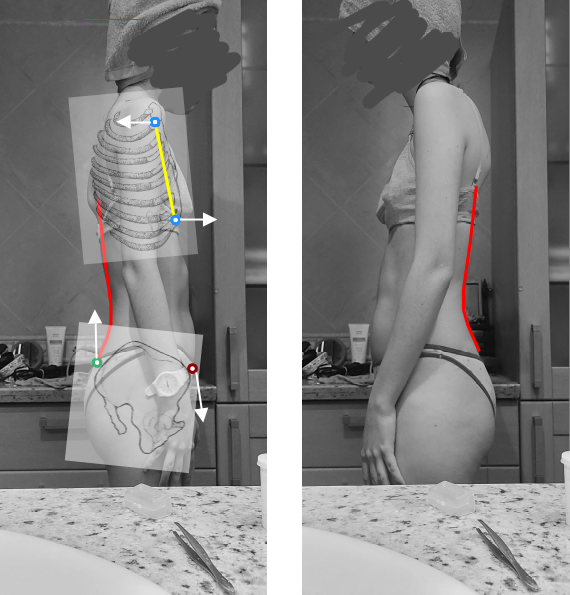Assessment context and image originals from this thread: https://www.reddit.com/r/PostureAssesments/comments/15emw5a/winged_scapula_and_spinal_fusion/
Ok, so I did what I could with the images available.
There is few assumptions I have made. Please correct me if I'm wrong, as I well may be.
1/ The spinal fusion allows for "normal range" of movement of the spine? As a spine without scoliosis would do? I'm assuming it does.
2/ When I see the scar at your back, I wonder if all the tissues (muscles / fascias) at your back have been affected / healed? Again, I assume normal function.
Basically, I will make the assessment as if you would be somebody without spinal fusion. The limitations associated with the surgery may need to be taken into account eventually.

On general basis, it's obvious you are shortening your torso. There is the distinct red arch in your lowerback.
On the right side view I also tried to superimpose your pelvis and ribcage for illustration. You can see that both are slightly rotated, each in an opposite direction. These two rotational movements (done habitually) affect the spine inbetween, arching it into the shape displayed.
On the Left side, I left it bare to show what we call "protruding abdomen" which is essentially an offset copy of the curve from your lowerback.
Your abdominal muscles are out of action, so is your serratus anterior.
If we would have your plumb line, you would see you are leaning too far forward with the middle and lower torso. To counterbalance, you retract your upper torso, arms and head.
You just simply pull one arm further back than the other, hence the winging scapula. With the scoliosis, it may be a little more complicated than as I described, as horizontal rotation of the torso is also present, but in principle, it's like that.
Both your arms are retracted too far back. But one is more.
You would most certainly benefit from learning "conscious guidance and control" which would allow you to move the parts of your mechanism to a position of mechanical advantage. (as opposed to what you have know - mechanical disadvantage).
The principals of bio-mechanics and physics we use apply regardless of you being pre or post-operation.
The difference post operation is that I would be taking precautions to make sure that the model i'm using (based on a "healthy" human) is still applicable in the case of post surgery. If the fusion changes the mechanical properties of the spine or for example if the thoracolumbar fascia has been damaged / reduced during operation, we may need to take this into account when adjusting the model.
All other principals remain the same.
I'd be happy to teach you. It would be an exchange in the form of mutual education. You can learn how the initial Alexander Technique works and I could get some deep insight into what it's like to work with scoliosis patient.
I know for a fact that Jeando Masoero has previous experience teaching people with scoliosis and I believe the results are good. I would like get first hand experience of that as well.